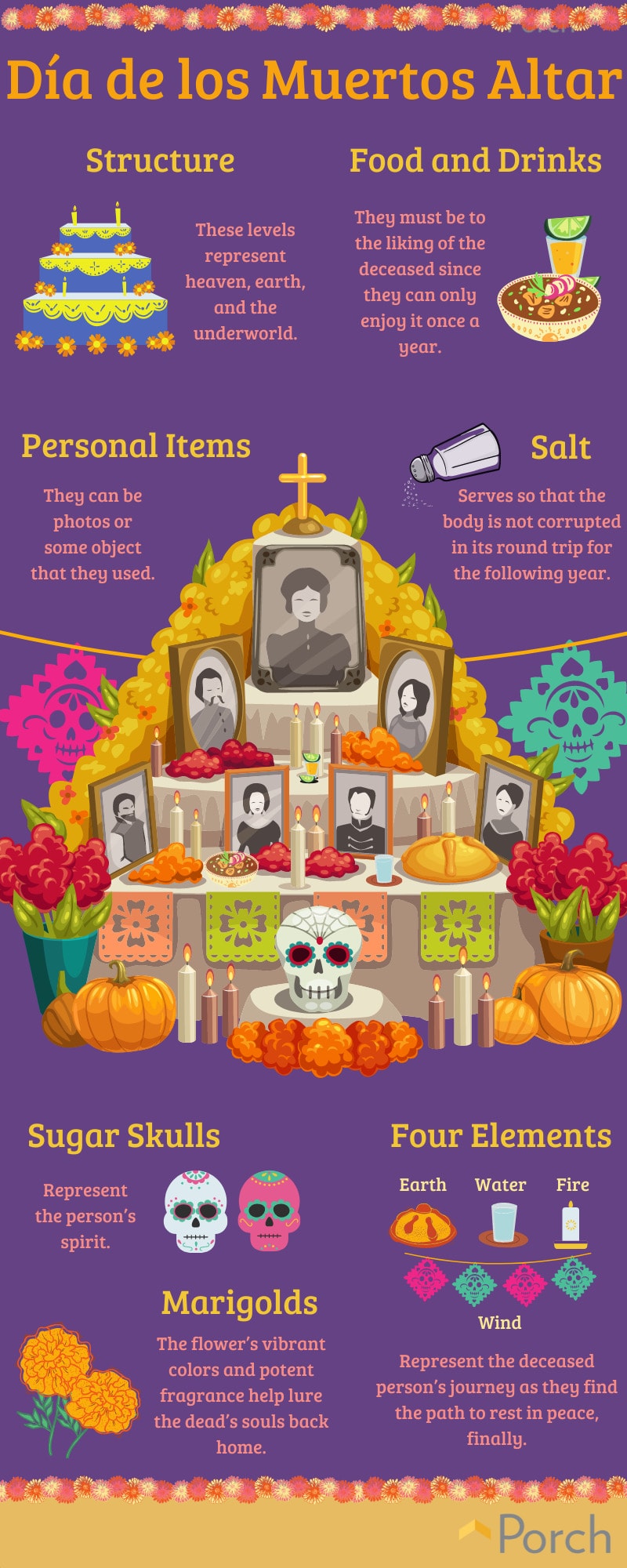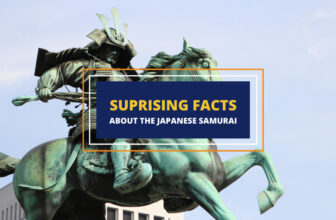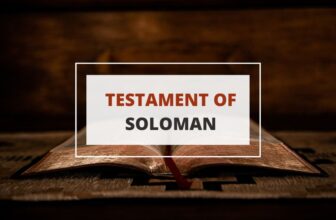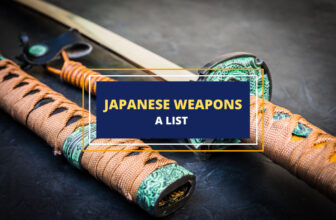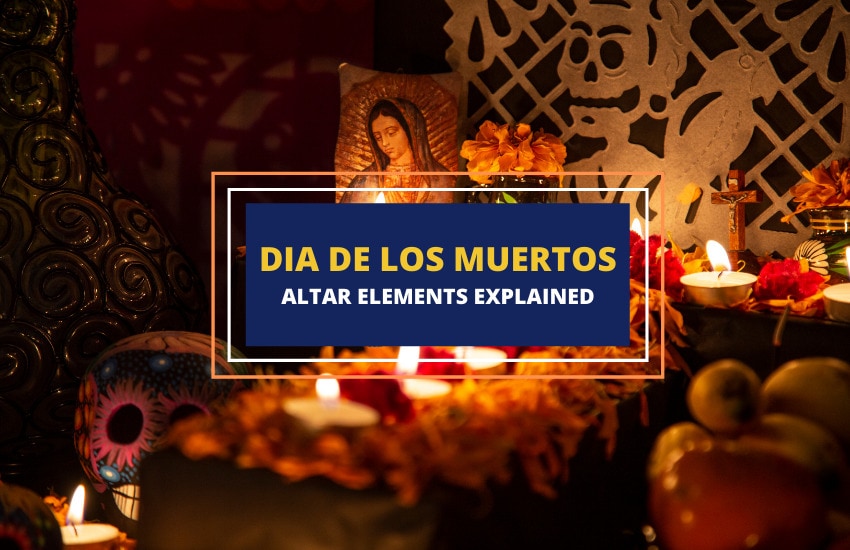
Table of Contents
Día de los Muertos is a multiple day holiday that originated in Mexico, and which celebrates the dead. This festivity takes place on the 1st and 2nd of November. It’s believed that during this celebration, the spirits of the dead come back to spend some time among the living, so families and friends gather to welcome the souls of their loved ones.
One of the most significant traditions associated with this holiday is the decoration of personalized, homemade altars (known as ofrendas in Spanish), dedicated to the memory of the departed.
Altars are homemade and personalized, so each one of them is unique in its own way. However, traditional altars share a series of common elements, such as its structure, and the elements on top of it, including modeled human skulls (made of clay or ceramic), salt, marigolds flowers, food, drinks, some of the deceased’s personal belongings, candles, copal, incense, sugar skulls, water, and paper cortado cut-outs.
Here’s a closer look at the history and elements of a traditional Día de los Muertos altar, and what each of these represents.
The Historical Origins of Día de los Muertos Altar
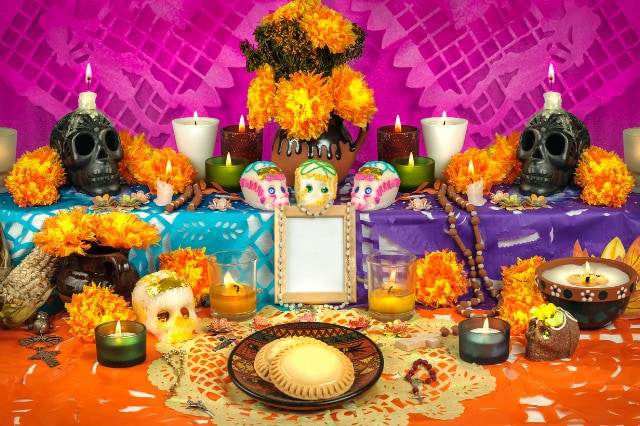
The roots of Día de los Muertos’ go deep into the Aztec era of Mexico. In ancient times, the Aztecs held many rituals throughout the year to honor their dead.
However, after the Spaniards conquered Mexico in the 16th century, the Catholic Church moved all indigenous traditions concerning the cult of the dead to November 1st (the Day of All Saints) and 2nd (the Day of all Souls), so they would fit into the Christian calendar.
Eventually, the solemnity with which these two holidays were celebrated was replaced by a much more festive attitude, as Mexicans started to approach death with a particular sense of ‘cheerfulness’. Today, the celebration of the Día de los Muertos blends elements from both the Aztec and the Catholic traditions.
This syncretism is the reason why finding the exact historical origin of the Día de los Muertos altars can become a difficult task. Nevertheless, since the adoration of ancestors is forbidden in Catholicism, it seems far safer to assume that the religious substrate from which this element emerged primarily belongs to the Aztecs.
Elements of Dia de los Muertos Altar
1. Structure
The structure of the Día de los Muertos altar often has several levels. This multi-level structure is believed to represent the three layers of the creation that exists in Aztec mythology – the heavens, the earth, and the underworld.
To set up the structure of the altar, celebrants choose a space of their house cleared of its traditional furnishings. In that location, an array of wooden crates placed one atop another is displayed. Other types of containers can also be used, as long as they provide enough stability.
Many people also use a table as the base of their altar, to increase its height. The whole structure is usually covered with clean tablecloths.
2. Salt
Salt represents the prolongation of life after death. Moreover, salt is supposed to purify the souls of the dead, so the departed’s spirits can continue with their round journey every year.
It’s also worth mentioning that in many religious traditions around the world, salt is closely associated with the beginning of life.
3. Marigolds
Fresh flowers are usually used to decorate the altar of the dead, with the cempasúchil flower, or marigolds, being the option preferred among Mexicans. In Mexico, marigolds are also called flor de muerto, which means ‘flower of the dead’.
The ritualistic uses of the marigold can be traced back to the time of the Aztecs, who believed that the flower had curative powers. However, the beliefs regarding marigolds have changed over time. Modern-day Mexican tradition has it that the bright orange and yellow colors and the strong scent of this flower can be used to let the dead know which road would take them to their altars.
This is why many people leave a trace of marigold’s petals between the tombs of their loved ones and their houses. Another flower that is usually used to this end is the barro de obispo, also known as cockscomb.
4. Food and Drinks
On Día de los Muertos, celebrants also include food and drinks on the altar, so the souls of their loved ones can enjoy, at least once a year, their favorite meals.
Some of the traditional foods served during this holiday are tamales, chicken, or meat in mole sauce, sopa azteca, amaranth seeds, atole (corn gruel), apples, bananas, and pan de muerto (‘bread of the dead’). The latter is a sweet roll, whose top is decorated with two crossed bits of dough, shaped like bones.
Regarding drinks, water is always present among the offerings to the dead, as people believe that the spirits become thirsty during their round journey to the land of the living. However, more festive beverages, such as tequila, mezcal, and pulque (a traditional Mexican liquor) are also served for this occasion.
Sweet foods are specially offered during November first, as Mexicans commemorate children who are deceased, referred to as angelitos (or ‘little angels’), on this day. November second is more associated with the celebration of adults who have passed away.
5. Personal Items
Some of the dead’s personal items are also frequently displayed on the altar, as a way to maintain the memory of those who have departed.
Photographs of the deceased, clothes such as hats or rebozos, pipes, watches, rings, and necklaces are among the personal belongings traditionally placed on the altar during this holiday. Toys are also commonly found on the altars of deceased children.
6. Candles and Votive Lights
It’s believed that the warm glow provided by the candles and other votive lights helps the dead to find their way to their altars, especially during the night. Candles are also associated with the notions of faith and hope.
It’s also worth noting that in many Latin American Catholic communities, such as the Mexican, candles are offered to the animas (the dead’s souls), to ensure that they can find peace and rest in the afterlife.
7. Sugar Skulls
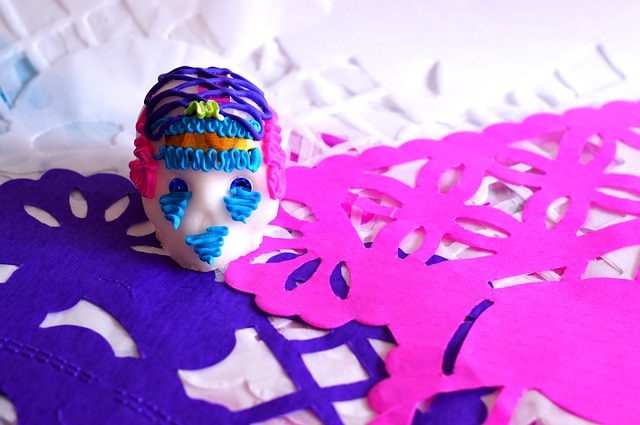
Sugar skulls are supposed to represent the spirits of the departed. However, there is nothing scary about these edible skulls, as they are usually decorated with cartoonish expressions.
Sugar skulls are sometimes accompanied by other traditional Día de los Muertos sweets, such as coffins-shaped candies and the bread of the dead.
8. Skulls
Molded on clay or ceramics, these human skulls confront the celebrants of this holiday with their mortality, thus serving as a reminder for the living that they too, one day, will become dead ancestors.
Consequently, it’s believed that skulls placed on Día de los Muertos altars not only represent death but also the importance of cyclically paying respects to the dead.
9. Four Elements
The four elements are associated with the journey that the dead have to complete every time they come back to the world of the living.
On the altar, a manifestation of every element is symbolically displayed:
- Food is linked to earth
- A glass of water represents the water element
- Candles are connected to fire
- The papel picado (colorful tissue paper cut-outs with intricate designs) is identified with the wind
In the last case, the association between the paper figurines and the wind is given by the movements made by the papel picado whenever an air stream flows through it.
10. Copal and Incense
It’s believed that sometimes mischievous spirits can try to steal the offerings dedicated to other souls. This is why during the Día de los Muertos, families and friends purify their houses by burning copal resin.
Curiously enough, the use of copal for ceremonial purposes can be traced back to the times of the Aztecs, even though incense was first introduced to Latin America by the Catholic Church. As with copal, incense is used to drive away bad spirits and facilitate the act of praying with its fragrances.
Conclusion
Building the altar during the Día de los Muertos is one of the fundamental components of this holiday. Originating in Mexico, this tradition blends elements from both the Aztec and the Catholic ceremonies. These altars remember the deceased, paying respect to them in their own unique way.




